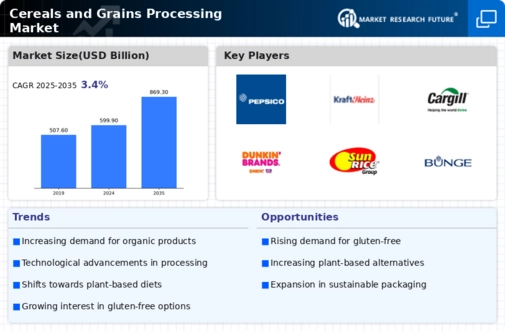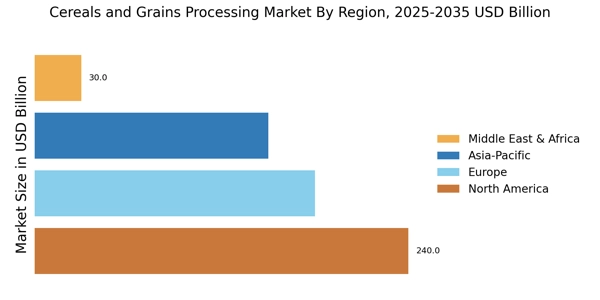Rising Demand for Plant-Based Foods
The increasing consumer inclination towards plant-based diets is a pivotal driver for the Cereals and Grains Processing Market. As more individuals adopt vegetarian and vegan lifestyles, the demand for cereals and grains as primary protein sources escalates. This trend is reflected in market data, indicating that the plant-based food sector is projected to grow at a compound annual growth rate of approximately 11% over the next five years. Consequently, processors are innovating to create diverse products that cater to this burgeoning market, enhancing their offerings with grains such as quinoa, oats, and barley. The Cereals and Grains Processing Market is thus witnessing a transformation, as manufacturers strive to meet the nutritional needs of health-conscious consumers.
Growing Awareness of Nutritional Benefits
The heightened awareness regarding the nutritional benefits of cereals and grains is a crucial driver for the Cereals and Grains Processing Market. Consumers are increasingly recognizing the importance of whole grains in their diets, which are associated with various health benefits, including reduced risk of chronic diseases. This awareness is reflected in market trends, with whole grain products experiencing a surge in demand, leading to a projected market growth of 8% annually. As a result, processors are focusing on developing products that highlight these health benefits, such as fortified cereals and grain-based snacks. The Cereals and Grains Processing Market is thus adapting to meet the evolving preferences of health-conscious consumers.
Sustainability and Eco-Friendly Practices
Sustainability has emerged as a significant driver within the Cereals and Grains Processing Market, as consumers increasingly favor eco-friendly products. The demand for sustainably sourced grains and environmentally responsible processing methods is on the rise. Market data indicates that products labeled as organic or sustainably produced are witnessing a growth rate of approximately 12% annually. This shift compels processors to adopt practices that minimize environmental impact, such as reducing water usage and implementing waste recycling systems. Consequently, the Cereals and Grains Processing Market is evolving to align with consumer expectations for sustainability, fostering a more responsible approach to food production.
Expansion of E-Commerce and Online Retailing
The expansion of e-commerce and online retailing is significantly influencing the Cereals and Grains Processing Market. As consumers increasingly turn to online platforms for grocery shopping, the demand for convenient and accessible grain products is surging. Market data reveals that online grocery sales are projected to grow by 20% over the next few years, prompting processors to enhance their distribution strategies. This shift not only allows for a broader reach but also enables companies to engage directly with consumers, fostering brand loyalty. The Cereals and Grains Processing Market is thus adapting to this digital transformation, ensuring that products are readily available to meet the evolving shopping preferences of consumers.
Technological Innovations in Processing Techniques
Technological advancements are reshaping the Cereals and Grains Processing Market, enabling more efficient and sustainable production methods. Innovations such as high-temperature short-time processing and extrusion technology are enhancing the nutritional profile of processed grains while reducing energy consumption. For instance, the adoption of automated systems and artificial intelligence in processing plants is streamlining operations, leading to increased productivity and reduced waste. Market data suggests that investments in processing technology are expected to rise significantly, with a projected increase of 15% in capital expenditure over the next three years. This trend not only improves product quality but also aligns with the industry's shift towards sustainability.


















Leave a Comment